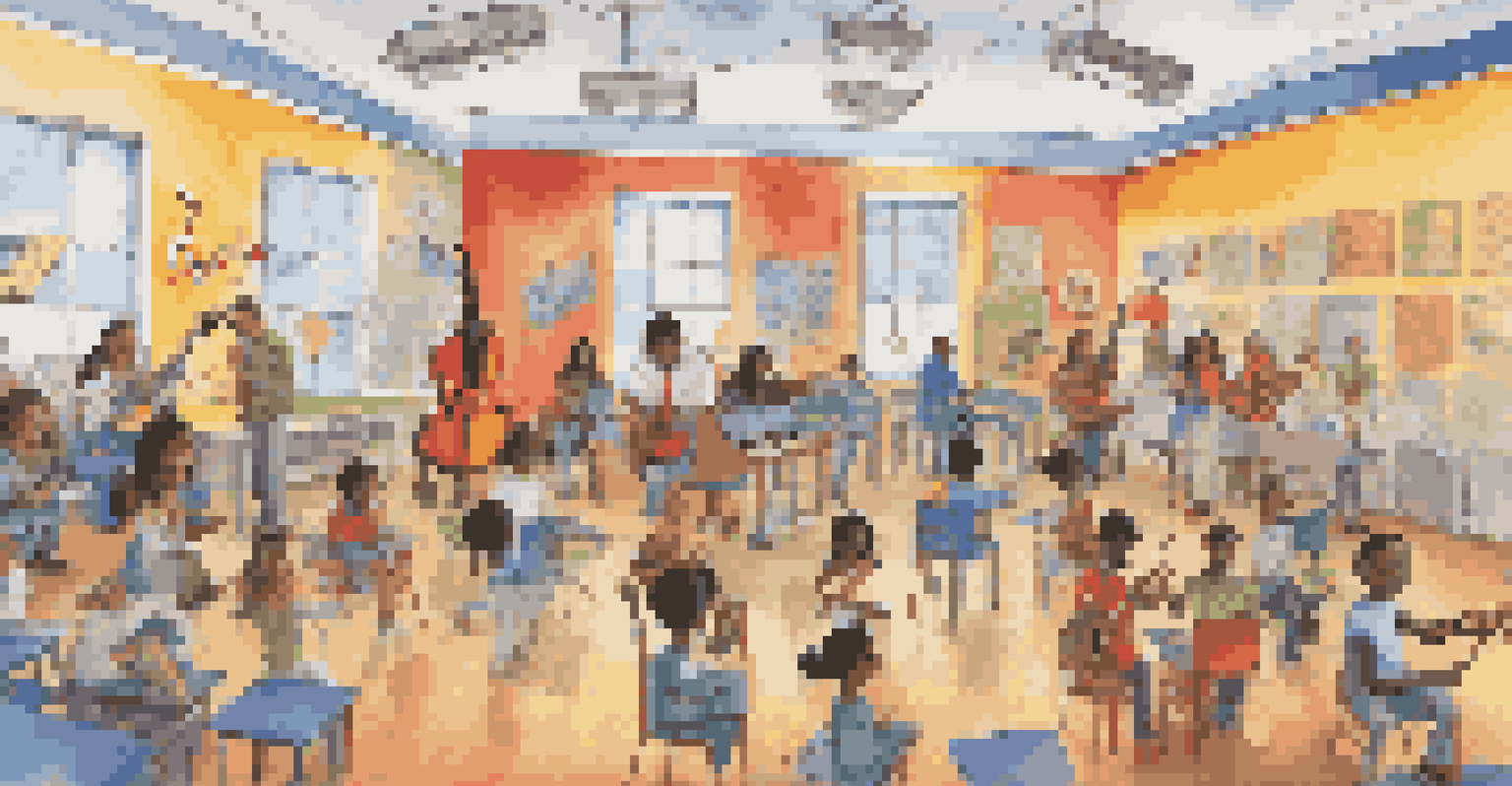Exploring the Use of Music Streaming for Classroom Engagement

Understanding the Power of Music in Learning Environments
Music has a unique ability to evoke emotions and foster connections, making it a powerful tool in the classroom. By tapping into this universal language, educators can create a more engaging and inviting atmosphere for students. Imagine walking into a classroom where upbeat music fills the air, instantly lifting spirits and setting a positive tone for the day.
Music can change the world because it can change people.
Research shows that music can enhance memory retention and boost creativity, which are essential components of effective learning. For instance, pairing educational content with relevant songs can help students remember complex concepts more easily. Just think of how jingles help us recall brand names; the same principle applies to classroom learning.
Moreover, music can help bridge cultural gaps among students. By introducing diverse genres from around the world, teachers can promote inclusivity and spark discussions about different backgrounds and experiences. This not only enriches the learning experience but also fosters a sense of belonging in the classroom.
Using Music Streaming Services to Engage Students
With the rise of music streaming platforms, teachers have access to vast libraries of songs and playlists that can enhance their lesson plans. Services like Spotify or Apple Music allow educators to curate playlists that align with specific themes or subjects. For example, a history lesson on the Civil Rights Movement could be paired with powerful protest songs from that era, deepening students' understanding.

These platforms also offer collaborative features, enabling students to contribute their own song selections. This not only empowers them but also makes them feel more invested in their learning experience. Imagine a classroom where students are excited to share their music choices, leading to discussions about cultural significance and personal relevance.
Music Enhances Learning Engagement
Incorporating music in the classroom can create a more engaging and inviting atmosphere that boosts memory retention and creativity.
Additionally, the flexibility of music streaming means that lessons can be easily adapted on the fly. Teachers can switch tracks to match the mood or energy of the class, creating a dynamic and responsive learning environment. This adaptability helps keep students engaged and excited about learning.
Crafting the Perfect Playlist for Different Subjects
Creating tailored playlists for various subjects can significantly enhance student engagement. For instance, upbeat tracks can energize students during a math lesson, while calming music can help them focus during reading time. By strategically selecting songs that match the lesson's objectives, teachers can create a more conducive learning atmosphere.
Without music, life would be a mistake.
Consider incorporating instrumental music for subjects that require concentration, such as writing or science experiments. This allows students to immerse themselves in their tasks without the distraction of lyrics. On the other hand, using lyrical songs for language arts can aid in vocabulary building and comprehension.
Don't forget to involve students in the playlist creation process! When they have a say in the music being played, it fosters a sense of ownership and responsibility in their learning environment. This collaborative approach can lead to increased motivation and enthusiasm for the subject matter.
Integrating Music into Group Activities and Projects
Music can serve as an excellent backdrop during group activities, helping to set the mood and enhance collaboration among students. For instance, playing soft music during group discussions can create a relaxed atmosphere, encouraging shy students to participate more. This subtle integration of music can break down social barriers and foster teamwork.
Additionally, incorporating music into projects can make assignments more enjoyable and engaging. For instance, students could create presentations accompanied by a soundtrack that complements their topic. This not only enhances their creativity but also teaches them to think critically about the relationship between audio and visual content.
Tailored Playlists Boost Focus
Crafting specific playlists for different subjects helps to energize or calm students, enhancing their learning experience.
Furthermore, educators can use music to mark transitions between activities. For example, a short song can signal the end of one task and the beginning of another, helping students to shift their focus more smoothly. This rhythmic transition can also help manage classroom behavior, keeping students engaged and on task.
The Role of Music in Emotional and Social Development
Music has the power to evoke emotions, which can be particularly beneficial in a classroom setting. By incorporating music into lessons, teachers can help students express their feelings and experiences more openly. This emotional connection can create a supportive environment where students feel safe to share and learn from one another.
Moreover, music can serve as a tool for social development. Group activities that involve music encourage collaboration and communication among students. For instance, when students work together to create a project that includes a musical element, they learn valuable teamwork skills that will serve them well beyond the classroom.
Incorporating discussions about the themes and messages in songs can also promote empathy and understanding. By exploring the stories behind the music, students can gain insights into different perspectives and cultures. This not only enriches their emotional intelligence but also cultivates a more inclusive classroom environment.
Overcoming Challenges in Using Music in the Classroom
While the benefits of using music in classrooms are clear, there can be challenges in its implementation. One common concern is the potential for distraction. It's essential for educators to find the right balance when integrating music, ensuring it enhances rather than detracts from the learning experience. This might involve choosing the right volume or selecting appropriate genres for specific activities.
Another challenge is the diverse musical preferences of students. What resonates with one student might not appeal to another, leading to potential disengagement. To combat this, educators can involve students in the selection process, allowing them to share their favorite tracks and suggest songs that relate to the lesson.
Music Fosters Social Connections
Using music in group activities encourages collaboration and communication, helping students develop valuable social skills.
Lastly, educators may need to navigate copyright issues when using music in the classroom. Understanding the legalities around music usage can be daunting, but many streaming services offer educational licenses or curated playlists specifically designed for classroom use. This ensures that teachers can implement music seamlessly and legally in their lessons.
Measuring the Impact of Music on Classroom Engagement
To truly understand the effectiveness of music in enhancing classroom engagement, it's essential to measure its impact. Educators can gather feedback from students through surveys or discussions, asking them how music influences their learning experience. This valuable input can help teachers refine their approach and make necessary adjustments.
Additionally, observing changes in student behavior, participation levels, and overall enthusiasm can provide insights into the impact of music. For instance, if students show increased interest in a subject after introducing music, it's a clear sign that this approach is working. Tracking these changes over time can help educators build a case for the continued use of music.

Lastly, sharing success stories and strategies with fellow educators can foster a collaborative environment where music becomes a staple in classrooms. By exchanging ideas and experiences, teachers can inspire each other to explore creative ways to harness the power of music for enhanced engagement and learning.